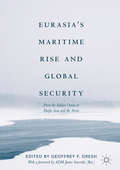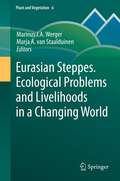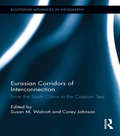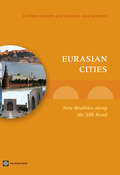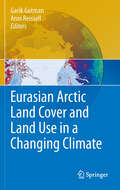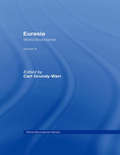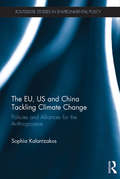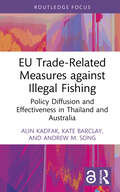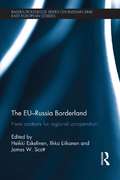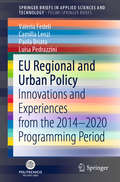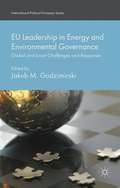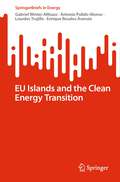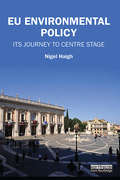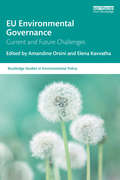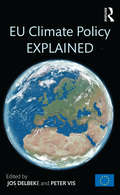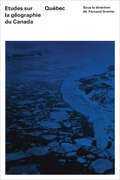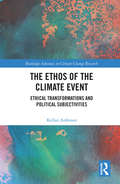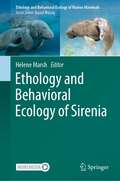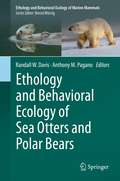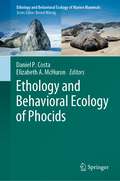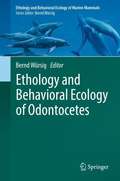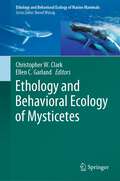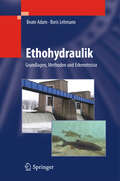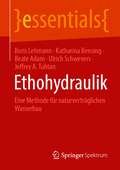- Table View
- List View
Eurasia’s Maritime Rise and Global Security: From The Indian Ocean To Pacific Asia And The Arctic (Palgrave Studies in Maritime Politics and Security)
by Geoffrey F. GreshThis book explores Eurasia’s growing embrace of its maritime geography from the Indian Ocean to Pacific Asia and the Arctic. In an age of climate change, the melting of the Arctic will transform Eurasia’s importance, in addition to influencing the political, economic, and military dynamics across Eurasia’s main maritime regions. These emerging shifts have already begun to alter maritime trade and investment patterns, and thus the global political economy. It also creates a rising threat to the current status quo of world order that has long been dominated by the Atlantic World. This edited volume showcases some of the world’s leading experts and examines Eurasia from a saltwater perspective, analyzing its main maritime spaces in a threefold manner—as avenue, as arena, as source—to show the significance of this geostrategic change and why it matters for the future of the world’s oceans.
Eurasian Steppes. Ecological Problems and Livelihoods in a Changing World
by Marinus J.A. Werger Marja A. van StaalduinenSteppes form one of the largest biomes. Drastic changes in steppe ecology, land use and livelihoods came with the emergence, and again with the collapse, of communist states. Excessive ploughing and vast influx of people into the steppe zone led to a strong decline in nomadic pastoralism in the Soviet Union and China and in severely degraded steppe ecosystems. In Mongolia nomadic pastoralism persisted, but steppes degraded because of strongly increased livestock loads. After the Soviet collapse steppes regenerated on huge tracts of fallow land. Presently, new, restorative steppe land management schemes are applied. On top of all these changes come strong effects of climate change in the northern part of the steppe zone. This book gives an up-to-date overview of changes in ecology, climate and use of the entire Eurasian steppe area and their effects on livelihoods of steppe people. It integrates knowledge that so far was available only in a spectrum of locally used languages.
Eurasian Corridors of Interconnection: From the South China to the Caspian Sea (Routledge Advances in Geography #10)
by Susan M. Walcott Corey JohnsonConnectivity, as well as conflict, characterizes Eurasia. This edited volume explores dynamic geopolitical and geo-economic links reconfiguring spaces from the eastern edge of Europe through the western edge of Asia, seeking explanation beyond description. The ancient Silk Road tied together space, much as pipelines, railroads, telecommunications infrastructure, and similar cultural and constructed links ease the mobility of people and products in modern Eurasia. This book considers Eurasia along an interlinked corridor, with chapters illustrating the connections as a discussion foundation focusing on the shared interactions of a set of nation states through time and across space, generating more positive considerations of the resurgently important region of Eurasia. China’s interests fall into three chapters: the southeastern border with Vietnam, the southwestern Himalayan edge, and the western Muslim regions. Russia’s recovery relates events to a larger landmass context and focuses on the importance of historic mobility. A geo-history of the Caspian considers this petroleum-rich area as a zone of cultural and economic interconnection. The final focus on Central Asia treats the traditional heart of “Eurasia”. The concluding chapter pulls together strands linking subregions for a new concept of “Eurasia” as an area linked by vital interests and overlapping histories.
Eurasian Cities: New Realities along the Silk Road
by Souleymane Coulibaly Uwe Deichmann William R. Dillinger Marcel Ionescu-Heroiu Ioannis N. Kessides Charles Kunaka Daniel SaslavskyThis report responds to pressing questions for policymakers in Eurasian cities and national governments. Faced with changing economic circumstances and a reorientation of trade toward Europe and Asia, will Eurasia's cities be able to adjust? Will some cities be granted the flexible regulations and supportive policies necessary for growth? And will some be permitted to shrink and their people assisted in finding prosperity elsewhere in the region?Even as Eurasian cities diverge, they face shared challenges. Policymakers have a key role in assisting spatial restructuring, particularly in addressing imperfect information and coordination failures. They can do so by rethinking cities, better planning them, better connecting them, greening them and finding new ways to finance these changes. Eurasian cities will also have to find the right balance between markets and institutions to become sustainable. As the World Development Report 2009: Reshaping Economic Geography illustrates, Eurasia (excluding Russia) is a 3D region- a region with low density, long distance, and many divisions. Securing accessibility to leading regional markets such as China, India, and Russia is thus critical. This will require key institutions to be developed to unite the countries, key connective infrastructures to be established between domestic and regional markets, and targeted interventions to be undertaken to compensate countries for short-term losses from this deepened economic integration. Policymakers at the highest levels in these countries should put accessibility at the top of their agendas.
Eurasian Arctic Land Cover and Land Use in a Changing Climate
by Garik Gutman Anni ReissellThis volume is a compilation of studies on interactions of land-cover/land-use change with climate in a region where the climate warming is most pronounced compared to other areas of the globe. The climate warming in the far North, and in the Arctic region of Northern Eurasia in particular, affects both the landscape and human activities, and hence human dimensions are an important aspect of the topic. Environmental pollution together with climate warming may produce irreversible damages to the current Arctic ecosystems. Regional land-atmosphere feedbacks may have large global importance. Remote sensing is a primary tool in studying vast northern territories where in situ observations are sporadic. State-of-the-art methods of satellite remote sensing combined with GIS and models are used to tackle science questions and provide an outlook of current land-cover changes and potential scenarios for the future. Audience: The book is a truly international effort involving U.S. and European scientists. It is directed at the broad science community including graduate students, academics and other professionals in this field.
Eurasia: World Boundaries Volume 3 (World Boundaries Series #Vol. 3)
by Carl Grundy-WarrEurasia offers a wide-ranging and original interpretation of territory, boundaries and borderlands in Europe, Asia and the Far East. This forms part of a unique series of books focussing on world boundaries which embrace the theory and practice of boundary delimitation and management, boundary disputes and conflict resolution, and territorial change in the new world order.
The EU, US and China Tackling Climate Change: Policies and Alliances for the Anthropocene (Routledge Studies in Environmental Policy)
by Sophia KalantzakosThe feeling of optimism that followed the COP 21 Paris Conference on Climate Change requires concrete action and steadfast commitment to a process that raises a number of crucial challenges: technological, political, social, and economic. As climate change worsens, new robust leadership is imperative. The EU, US and China Tackling Climate Change examines why a close collaboration between the EU and China may result in the necessary impetus to solidify a vision and a roadmap for our common future in the Anthropocene. Kalantzakos introduces a novel perspective and narrative on climate action leadership through an analysis of international relations. She argues that a close EU-China collaboration, which does not carry the baggage of an imbedded competition for supremacy, may best help the global community move towards a low carbon future and navigate the new challenges of the Anthropocene. Overall, Kalantzakos demonstrates how Europe and China, already strategic partners, can exercise global leadership in an area of crucial common interest through their web of relations, substantial development aid, and the use of soft power tools throughout the developing world. This book will be of great interest to students and scholars of environmental politics, international relations, climate change and energy law and policy.
EU Trade-Related Measures against Illegal Fishing: Policy Diffusion and Effectiveness in Thailand and Australia (Routledge Focus on Environment and Sustainability)
by Andrew M. Song Kate Barclay Alin KadfakFocusing on the experiences of Thailand and Australia, this book examines the impact of trade-restrictive measures as related to the EU’s regulations to prevent Illegal, Unreported and Unregulated (IUU) fishing. It is widely accepted that IUU fishing is harmful, and should be stopped, but there are different approaches to tackling it. Acknowledging this, this book argues that major efforts to fight IUU fishing require careful analyses if the goal is to achieve optimal results and avoid unintended consequences. The book draws on the recent experiences of Thailand and Australia to offer an empirical examination of one increasingly prominent solution, trade-restrictive measures. With Thailand representing direct, active intervention by the EU and Australia a more indirect dispersion of policy narratives and discourses, the book provides a rounded view on how likely it is that different countries in different situations will adapt to the changing policy norms regarding IUU fishing. Understanding the reactions of countries who might be targeted, or otherwise be influenced by the policy, generates new knowledge that helps inform a more effective and scalable implementation of the policy on the part of the EU and a better governance preparedness on the part of non-EU fishing nations. In broader terms, this book exposes a key moment of change in the compatibility between environmental regulations and international trade. The EU IUU policy is a prime example of a policy that uses the mechanisms of international trade to account for environmental and conservation objectives. By way of the unilateral and trade-restrictive stance against IUU fishing, the EU has positioned itself as a major market and normative power, driving its sustainability norms outwards. This book sheds light on the efficacy of this policy setup based on the analysis of country perspectives, which is a key factor influencing its potential spread. This book will be of interest to students and scholars of international fisheries politics, marine conservation, environmental policy and international trade, and will also be of interest to policymakers working in these areas.
The EU-Russia Borderland: New Contexts for Regional Cooperation (BASEES/Routledge Series on Russian and East European Studies)
by Heikki Eskelinen Ilkka Liikanen James W. ScottAfter the collapse of the Soviet Union, there were high hopes of Russia’s "modernisation" and rapid political and economic integration with the EU. But now, given its own policies of national development, Russia appears to have ‘limits to integration’. Today, much European political discourse again evokes East/West civilisational divides and antagonistic geopolitical interests in EU-Russia relations. This book provides a carefully researched and timely analysis of this complex relationship and examines whether this turn in public debate corresponds to local-level experience – particularly in border areas where the European Union and Russian Federation meet. This multidisciplinary book - covering geopolitics, international relations, political economy and human geography - argues that the concept ‘limits to integration’ has its roots in geopolitical reasoning; it examines how Russian regional actors have adapted to the challenges of simultaneous internal and external integration, and what kind of strategies they have developed in order to meet the pressures coming across the border and from the federal centre. It analyses the reconstitution of Northwest Russia as an economic, social and political space, and the role cross-border interaction has had in this process. The book illustrates how a comparative regional perspective offers insights into the EU-Russia relationship: even if geopolitics sets certain constraints to co-operation, and market processes have led to conflict in cross-border interaction, several actors have been able to take initiative and create space for increasing cross-border integration in the conditions of Russia’s internal reconstitution.
EU Regional and Urban Policy: Innovations and Experiences from the 2014–2020 Programming Period (SpringerBriefs in Applied Sciences and Technology)
by Valeria Fedeli Camilla Lenzi Paola Briata Luisa PedrazziniThe book critically reflects on some of the most important novelties and experimentations in the context of the European Union’s renewed urban and regional policy in the last programming period, 2014-2020. In particular, it examines four main innovations characterizing this period, which emerged as a result of the deep rethinking and reorganization of Cohesion Policy in the spirit of the place-based approach to local development, i.e. the development of the smart specialization strategy, the establishment of macro-regions, the focus on the urban dimension as a horizontal priority, and the role of social innovation in urban policy. Unlike other similar books, it analyzes the urban dimension of the reformed EU cohesion policy, especially focusing on its interplay with the regional dimension, and which has not been fully addressed to date. The book is intended for social scientists engaged in research on European issues, especially from regional and urban perspectives, policy-makers, particularly at the local level, and graduate students interested in regional and urban European matters.
EU Leadership in Energy and Environmental Governance: Global And Local Challenges And Responses (International Political Economy Series)
by Jakub M. GodzimirskiThis edited collection focuses on the impact of the changing global distribution of power on the EU's energy policy and ability to project its approach to energy-related issues abroad. It maps the EU's changing position on global energy, the impact of various factors on its energy policy, and its relations with Russia, China, the USA and Brazil.
EU Islands and the Clean Energy Transition (SpringerBriefs in Energy)
by Gabriel Winter-Althaus Antonio Pulido-Alonso Lourdes Trujillo Enrique Rosales-AsensioThis book explains the challenges and barriers of island energy systems in the European Union. It reviews the research projects carried out to date, and proposes a new feasible scheme that could be advantageous to many isolated energy systems. The book contains a thorough literature review, to ensure the originality of its ideas. It provides a clear insight of the opportunities and difficulties facing EU island energy systems.
EU Environmental Policy: Its journey to centre stage
by Nigel HaighAt a time when Europeans across the continent are focused on the EU's future direction, this book provides an important contribution to the current debate. Created for reasons quite unconnected with the environment, the EU has been given a compelling new justification by the success of its environmental policy. A number of factors – including a number of threats that came to prominence in the 1980s, and the new concept of 'sustainable development' – are responsible for pushing environmental policy to the forefront of its agenda. Nigel Haigh, a leading authority on the development and implementation of EU environmental policy, traces its evolution from obscurity to centrality. Drawing on a range of articles and lectures, he demonstrates how the EU has not only adapted itself to take on entirely new subject matter, but also has contributed to solving problems which individual Member States could not have dealt with on their own. The book goes on to contextualise the issues throughout its history and offers insight into the future role of the EU in environmental matters. This book is a valuable resource for academics and scholars as well as professionals and policy makers in the areas of environment and sustainability, politics, international relations and European affairs.
EU Environmental Governance: Current and Future Challenges (Routledge Studies in Environmental Policy)
by Amandine Orsini Elena KavvathaThis book presents an overview of the field of environmental law and policies within the European Union, from theoretical foundations to major issues and applied governance solutions. Drawing on expertise from renowned academics and practitioners from different disciplines, EU Environmental Governance: Current and Future Challenges helps readers to understand the main legal, political and economic issues of environmental protection since the adoption of the Paris Agreement by the European Union in 2015, until the 2020 Brexit, European Green Deal and coronavirus outbreak. The authors examine a broad range of sensitive and topical environmental issues including climate change, air pollution, waste management and circular economy, nuclear waste, biodiversity, agriculture, chemicals, nanotechnology, the environmental impacts of trade and environmental conflicts, presenting both current insights and future challenges. Overall, this volume exposes the reader to a vast array of empirical case studies, which will bolster their training and help tackle the environmental challenges faced by Europe today. This book is a valuable resource for students, researchers and policymakers across a broad range of fields, including environmental law and policies, environmental economics, climate science and environmental sociology.
EU Climate Policy Explained
by Jos Delbeke Peter VisThe EU has been the region of the world where the most climate policies have been implemented, and where practical policy experimentation in the field of the environment and climate change has been taking place at a rapid pace over the last twenty-five years. This has led to considerable success in reducing pollution, decoupling emissions from economic growth and fostering global technological leadership. <P><P>The objective of the book is to explain the EU's climate policies in an accessible way, to demonstrate the step-by-step approach that has been used to develop these policies, and the ways in which they have been tested and further improved in the light of experience. The book shows that there is no single policy instrument that can bring down greenhouse gas emissions, but the challenge has been to put a jigsaw of policy instruments together that is coherent, delivers emissions reductions, and is cost-effective. The book differs from existing books by the fact it covers the EU's emissions trading system, the energy sector and other economic sectors, including their development in the context of international climate policy. <P><P>Set against the backdrop of the 2015 UN Climate Change conference in Paris, this accessible book will be of great relevance to students, scholars and policy makers alike.
Etudes sur la Geographie du Canada
by Fernand GrenierThe publication of the series, 'Studies in Canadian Geography,' by the organizers of the 22nd International Geographical Congress, introduces to the international community of geographers a new perspective of the regional entities which form this vast countries. These studies should contribute to a better understanding among scholars, students, and the people of Canada of the geography of their land. Geographical works embracing the whole of Canada, few in number until recently, have become more numerous during the last few years. This series is original in its purpose of re-evaluating the regional geography of Canada. In the hope of discovering the dynamic trends and the processes responsible for them, the editors and authors of these volumes have sought to interpret the main characteristics and unique attributes of the various regions, rather than follow a strictly inventorial approach. In preparing this volume on Quebec, the contributors have looked at the evolution and present patterns of the ecumene of southern Québec, rural and urban Québec, and the dynamic biogeography of Québec.
The Ethos of the Climate Event: Ethical Transformations and Political Subjectivities (Routledge Advances in Climate Change Research)
by Kellan AnfinsonThis book develops a politico-ethical response to climate change that accounts for the novelty and uncertainty that it entails. This volume explores the ethical dimensions of climate change and posits that one must view it as a social construction intimately tied to political issues in order to understand and overcome this environmental challenge. To show how this ethos builds upon the need for new forms of responsiveness, Anfinson analyzes it in terms of four features: commitment, worldly sensitivity, political disposition, and practice. Each of these features is developed by putting four thinkers – Kierkegaard, Nietzsche, Schmitt, and Foucault respectively – in conversation with the literature on climate change. In doing so, this book shows how social habits and norms can be transformed through subjective thought and behavior in the context of a global environmental crisis. Presenting a multidisciplinary engagement with the politics, philosophy, and science of climate change, this book will be of great interest to students and scholars of climate change, environmental politics, environmental philosophy and environmental humanities.
Ethology and Behavioral Ecology of Sirenia (Ethology and Behavioral Ecology of Marine Mammals)
by Helene MarshDespite their rich fossil history, there are only four surviving species of sirenians or sea cows, the only fully aquatic herbivorous mammals. The three species of manatees and the dugong live in the coastal waters rivers and lakes of more than 80 tropical and subtropical countries and are all on the IUCN Red List of Threatened Species. This book examines sirenian conservation biology through the lens of their behavioral ecology and ethology. Sirenian feeding, diving, movement, social and reproductive behaviors are reviewed by an international team of scientists from eight countries, with an emphasis on data gathered in the past 15 years.
Ethology and Behavioral Ecology of Sea Otters and Polar Bears (Ethology and Behavioral Ecology of Marine Mammals)
by Randall W. Davis Anthony M. PaganoSea otters and polar bears are carnivorous marine mammals that still resemble their terrestrial ancestors. Compared with Cetacea (whales and dolphins), Sirenia (dugongs and manatees), and Pinnipedia (seals, sea lions, and walrus), they are less adapted for an aquatic life and the most recently evolved among marine mammals. Sea otters are amphibious but seldom come ashore, and polar bears primarily occur on sea ice or along the shore. When at sea, both species spend most of their time swimming at the surface or making short, shallow dives when foraging or pursuing prey. Indeed, polar bears rarely pursue seals in water. Nevertheless, polar bears are powerful swimmers and will stalk seals from the water. As with many other large carnivores, they are solitary hunters. Although sea otters are gregarious and form aggregations at sea called rafts, they are primarily asocial. Except during mating, the principal interaction among sea otters occurs between a female and offspring during the six-month dependency period. In large carnivores (e.g., wolves and lions) that feed on ungulates, sociality and cooperation are favored because of the need to capture large prey and defend carcasses. Polar bears, which are the largest terrestrial carnivore, are solitary hunters of seals and are neither gregarious nor social. Males and females briefly associate during courtship and mating. During this time, males aggressively compete for females. At other times, males generally avoid each other except for aggregations of males that form while summering on land, and females with cubs avoid males, which are known for infanticide. As with sea otters, the interaction of polar bears outside of mating occurs between a female and her offspring during the 2-3 year dependency period. This interaction is critically important when altricial cubs are born in the winter den. This book provides new insight into the ethology and behavioral ecology of sea otters and polar bears. Each chapter reviews the discoveries of previous studies and integrates recent research using new techniques and technology. The authors also address historic and current anthropogenic challenges for their survival as climate change alters entire marine ecosystems.
Ethology and Behavioral Ecology of Phocids (Ethology and Behavioral Ecology of Marine Mammals)
by Daniel P. Costa Elizabeth A. McHuronPhocid (or earless or true) seals are ecologically diverse, occupying habitats from the tropics to the poles in marine and freshwater and feeding on anything from tiny zooplankton to other marine mammals. There are 18 species of phocid seals, the smallest species (ringed seal) is more than 20 times smaller than the largest (southern elephant seal), with marked sexual dimorphism present in some species. This book examines the behavior, ecology, and physiology that allow phocid seals to inhabit such a wide range of habitats. The book is composed of 16 chapters written by 37 authors from 8 countries. The book first describes the general patterns of phocid behavior, followed by descriptions of what is known about well-studied species. We have taken a holistic approach, focusing not only on the behaviors themselves but also on the factors that constrain the expression of behavior and the proximate mechanisms driving behavior. In many cases, the chapters represent collaborations between well-established researchers and early-mid career individuals who bring new perspectives to help carry the field of phocid behavioral ecology well into the future.
Ethology and Behavioral Ecology of Otariids and the Odobenid (Ethology and Behavioral Ecology of Marine Mammals)
by Claudio Campagna Robert HarcourtThis book is focused on the marine mammalian groups the Otariidae and the Odobenidae, otherwise known as fur seals, sea lions and the walrus. In 30 chapters, more than 60 authors from 30 institutions and 13 nationalities, discuss a broad suite of topics from maternal care and mating behavior, through play, cognition and personality, to adaptation to life in the Anthropocene. The authors explore the behaviors that have allowed these semi-aquatic mammals to thrive in the marine realm. Many populations have recovered following historical decimation, with interesting evolutionary consequences which are explored. Detailed, selected, individual species descriptions are also provided, showcasing the behavioral diversity of this engaging, adaptive and highly successful group of marine mammals.
Ethology and Behavioral Ecology of Odontocetes (Ethology and Behavioral Ecology of Marine Mammals)
by Bernd WürsigThis book concentrates on the marine mammalian group of Odontocetes, the toothed whales, dolphins, and porpoises. In 23 chapters, a total of 40 authors describe general patterns of ethological concepts of odontocetes in their natural environments, with a strong bent towards behavioral ecology. Examples are given of particularly well-studied species and species groups for which enough data exist, especially from the past 15 years. The aim is to give a modern flavor of present knowledge of ethology and behavior of generally large-brained behaviorally flexible mammals that have evolved quite separately from social mammals on land. As well, the plight of populations and species due to humans is described in multiple chapters, with the goal that an understanding of behavior can help to solve or alleviate at least some human-made problems.
Ethology and Behavioral Ecology of Mysticetes (Ethology and Behavioral Ecology of Marine Mammals)
by Christopher W. Clark Ellen C. GarlandIn this book, an international team of leading marine mammal scientists, with a remarkably diverse set of backgrounds and areas of expertise, lead you through a synthesis of current knowledge on baleen whales. Baleen whales are the largest animals ever to have lived on this planet. They also have the lowest and most intense voices on Earth, most likely evolved to take advantage of ocean acoustic transmission conditions so as to be detectable across ocean basins. Some baleen whales can live to be 150-200 years old. They migrate many thousands of kilometers between feeding and breeding areas. They produce songs and calls that serve as behavioral foundations for establishing, maintaining and expanding their cultural identities. To conclude that we know the behavioral limits of these large brained, long-lived animals would be naïve. As baleen whale scientists, we are still beginning to comprehend the enormous complexities and natural histories of these remarkable animals.Today, the fact that whales sing is known throughout much of the world. This awareness started 50 years ago with the publication and popularization of a collection of humpback song recordings that motivated research into baleen whale behavioral ethology. In this book’s chapters, a reader’s experiences will stretch from learning about baleen whale laryngeal anatomy associated with their different voices to learning about the vast ocean areas over which their voices can be heard and the emerging complexities of their culturally defined societies. These are accompanied by chapters on the fundamental ethological contexts of socializing, migrating, and foraging. Two common themes permeate the book. One theme highlights the phenomenal increase in scientific knowledge achieved through technological advancements. The other theme recognizes the impacts of human-made activities on ocean acoustic environments and the resultant influences on the health and survival of individual whales and their populations. Although the book is intentionally ambitious in its scope, as scientists, we fully recognize that baleen whale science is still in its infancy. Many profound revelations await discovery by cohorts of young, multi-talented explorers, some of whom are stretching their wings in this volume and some of whom are reading these scientific stories for the first time.
Ethohydraulik
by Beate Adam Boris LehmannUm Fließgewässer den Nutzungsansprüchen des Menschen anzupassen, sind unzählige Baumaßnahmen erforderlich. Um die Auswirkungen wasserbaulicher Aktivitäten auf die in Fließgewässern lebenden Tiere zu untersuchen, wurde die Ethohydraulik entwickelt. Sie beruht auf der Ethologie (Erforschung des Verhaltens von Tieren) und der Hydraulik (Lehre von den bewegten Flüssigkeiten). Die Autoren stellen die Grundlagen dieser Wissenschaftsdisziplin dar und liefern Regeln sowie Grenz- und Bemessungswerte für die wasserbauliche Praxis.
Ethohydraulik: Eine Methode für naturverträglichen Wasserbau (essentials)
by Boris Lehmann Katharina Bensing Beate Adam Ulrich Schwevers Jeffrey A. TuhtanEthohydraulik agiert an der Schnittstelle zwischen Verhaltensforschung (Ethologie) und dem Strömungsverhalten (Hydraulik). Ethohydraulische Untersuchungen helfen, das hydraulisch-reaktive Verhalten von Wassertieren zu verstehen. Aus den Befunden lassen sich Grenz- und Richtwerte sowie Gestaltungsvorgaben für die Planung wasserbaulicher Anlagen ableiten. In diesem essential geben die Autoren einen Überblick über die Grundlagen und methodischen Ansätze ethohydraulischer Untersuchungen. Zudem werden Einsatzbereiche und aktuelle Weiterentwicklungen aufgezeigt.
